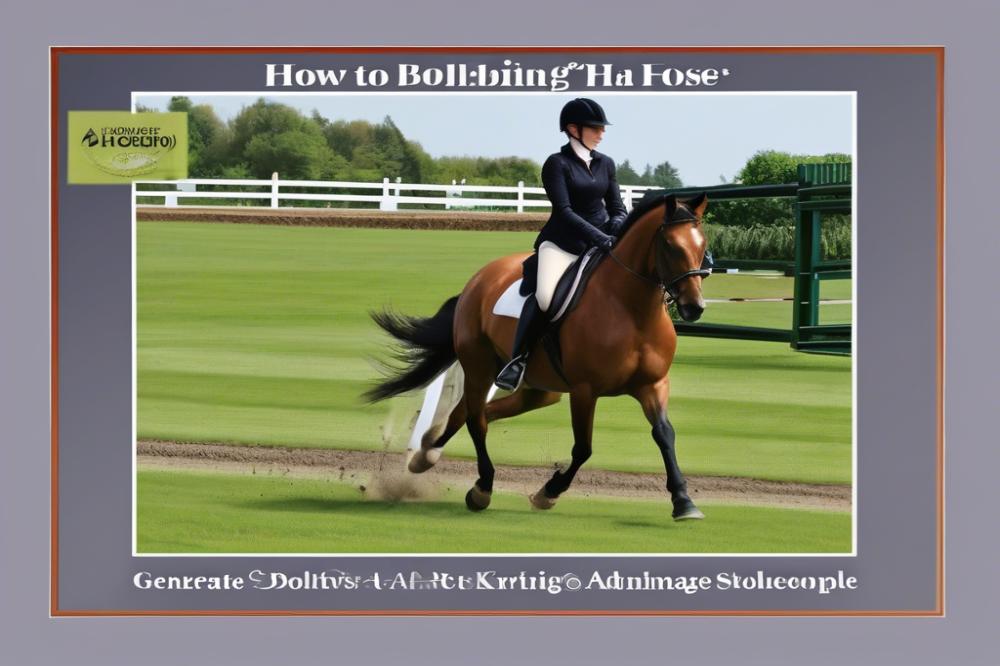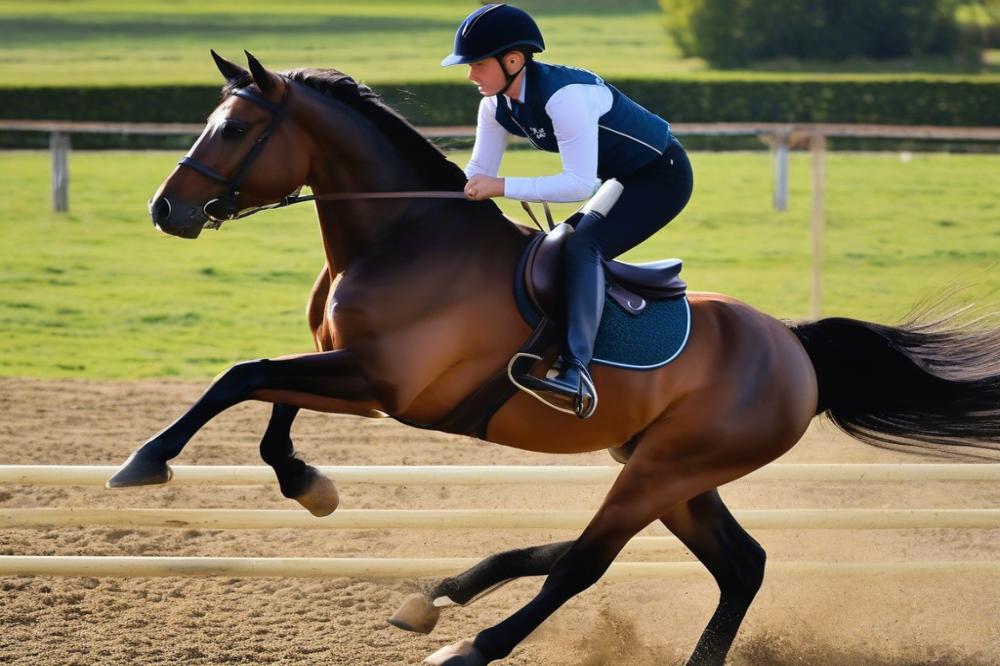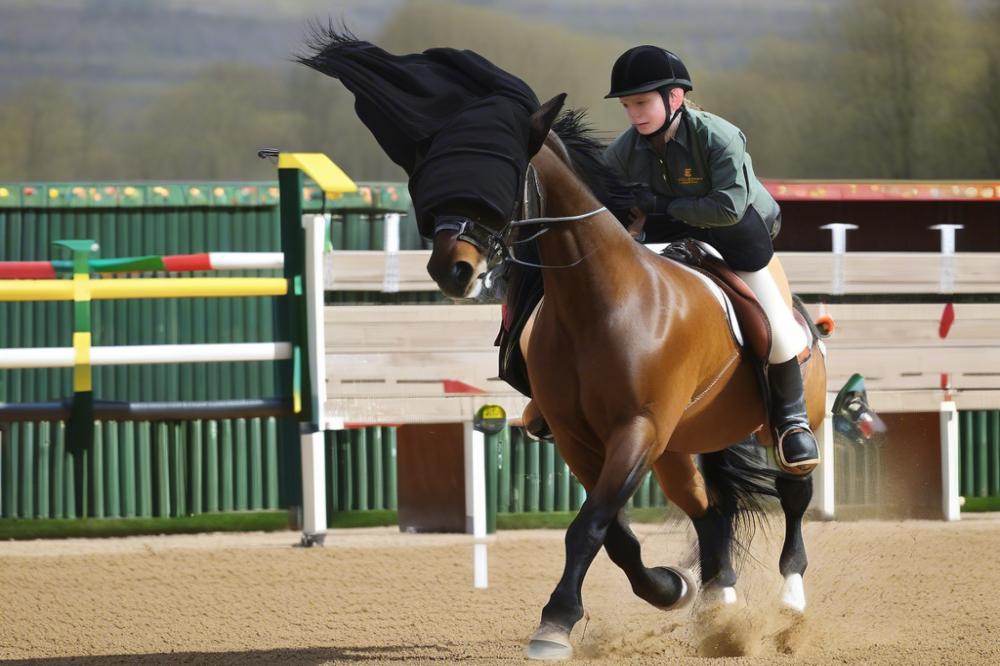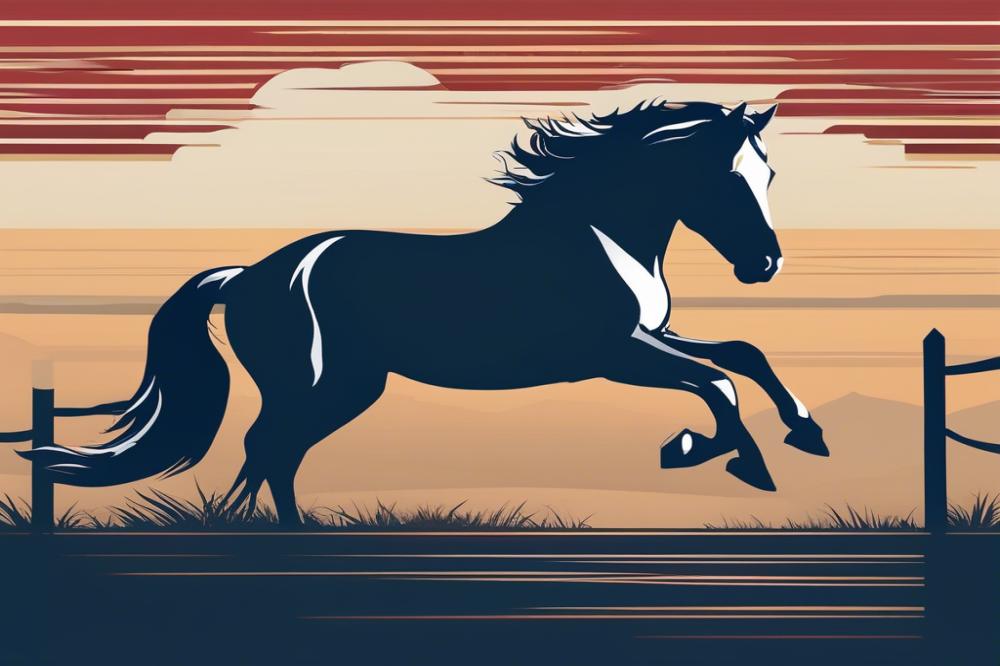Understanding Bolting in Horses
Imagine this: you’re out riding on a beautiful day, when suddenly, your horse decides that a bush is the ultimate enemy. In a split second, your calm ride turns into a wild chase as your horse bolts away! Bolting is when a horse suddenly runs away, often triggered by fear or excitement. This behavior can leave any rider feeling helpless and maybe a little scared. Knowing what bolting is and recognizing its causes can save both horse and rider from potentially dangerous situations.
The Importance of Addressing Bolting Behavior

Understanding bolting behavior is crucial for anyone involved in horse riding, training, or care. Horses are magnificent creatures, but they can also be quite unpredictable. When a horse bolts, it’s not just about getting from point A to point B quickly. It can lead to accidents that not only put the rider in jeopardy but can also harm the horse. This is why horse training techniques that focus on control and confidence are so important. A rider needs to gain a deeper understanding of what triggers their horse, whether it’s a sudden noise or an unexpected movement. If you can learn to read your horse’s body language, it’s almost as if you’ve unlocked a secret code!
What This Article Will Cover

This article will cover various bolting solutions that every rider should know. We’ll discuss effective equestrian techniques that can help prevent your equine friend from getting spooked. Think of it as preparing for a dance together—you wouldn’t want to step on each other’s toes! There will be some tips on horse care that can help create a calmer animal. Lastly, we’ll look at common scenarios with relatable stories to help make it all clearer. Who knows, you might even learn a thing or two about the fascinating differences between camel vs horse intelligence while we chat. After all, understanding your horse is like getting to know a 4 year old horse in human years—challenging yet incredibly rewarding!
Understanding Bolting

Bolting refers to a sudden, uncontrollable movement of a horse often characterized by a quick dash forward. This behavior can truly surprise even the most experienced riders. Understanding the triggers is crucial, as they set the stage for this reaction.
Common triggers include fear and anxiety. A loud noise, a sudden movement, or even a strange object can spark panic. Most horses react by bolting as part of their natural flight response. Essentially, they might feel threatened and their instinct is to run away. Fear can come from anywhere, even imagined threats. A cardboard box or a barking dog may send a horse into a tizzy.
Watching a horse before it bolts can unveil patterns. Horses often show signs of distress such as increased breathing rates or wide eyes. Some may shift their weight restlessly or prance about as if they can’t decide what to do. These behaviors serve as warnings that something isn’t right. Skilled riders must recognize these signals. If you see your horse acting skittish, it’s time to use those equestrian skills to redirect its focus.
Training plays a significant role in these situations. Effective horse training and care can help to reduce instances of bolting. Teaching your horse to respond calmly to stimuli is essential. Equestrian techniques aimed at desensitization can prepare your horse for unexpected occurrences. With patience, a horse can learn to handle frightful situations in a more composed manner. This preparation can make a big difference during a horse riding session.
Remember, not every spook leads to bolting. Many times, a horse might react but remain in control. However, when you see that shift to thrilling speed, it’s important to know how to respond. Employing bolting solutions efficiently can help manage the situation and restore calm. What matters most is creating an environment where your horse feels safe and secure.
Preventive Measures
When it comes to managing a bolting horse, groundwork training becomes your number-one ally. This practice lays the foundation for your equestrian skills. It helps you and your horse learn to communicate and develop trust. Think of groundwork as the glue that keeps your partnership strong. Horses feel safer when they understand their boundaries. So, spending time on the ground can really pay off.
Desensitization techniques play a crucial role in horse training. Horses often bolt due to sudden fears. For example, they might panic at the sound of a plastic bag or the sight of a shadow. Gradually exposing your horse to these common fears helps build confidence. Imagine a kid who’s afraid of the dark. A little torchlight goes a long way! By introducing these triggers slowly and calmly, your horse learns that they aren’t so scary after all.
Building a bond with your horse is akin to making a lifelong friend. Trust and communication go hand in hand. Simple things like grooming or spending quiet moments together make a huge difference. Horses are sensitive animals. When they feel that their rider has their back, they are more likely to stay calm. Remember, it’s not just about riding; it’s about relationship building.
Then there’s equipment fit, which is non-negotiable. Improperly fitted tack can cause discomfort, leading to unwanted behaviors. Picture yourself wearing shoes that are two sizes too small. Not fun at all! Checking your saddle, bridle, and reins ensures that your horse is both comfortable and safe. All these small measures contribute to fewer surprises when you’re out riding.
Implementing these equestrian techniques not only improves your riding experience but also provides bolting solutions when faced with challenges. It’s all about creating a positive environment. The more comfort and understanding you provide, the more your horse can focus on the ride and not on that scary bush or passing car!
Recognizing Early Signs
When it comes to equestrian skills, recognizing the early signs of a horse ready to bolt is crucial. Horses can’t speak, but they do communicate. Ears pinned back and wide eyes might tell you something is off. Their body posture can change too. A horse that shifts its weight to its back legs or twists its head sharply could be feeling nervous.
Understanding horse behavior requires keen observation. Each horse is unique, but many share common traits. Observe how they react in different situations. Is your horse suddenly more jumpy around objects it usually ignores? Maybe they’re spooking at imaginary monsters! This kind of awareness can help you catch the signs before things escalate.
Staying calm is another vital part of equestrian techniques. When a horse senses anxiety from its rider, it often gets anxious too. Take a breath. Visualize a peaceful field, or maybe think of a favorite joke. Laughter can ease tension, even if it’s just a chuckle at your own goofy thoughts. Keeping your own composure can work wonders for your horse.
Use simple cues to redirect their focus. Talking softly can help soothe them, just like a gentle pat can bring comfort. Sometimes, offering a treat can distract a nervous horse. Noticing early signs means you have the chance to act before things spiral out of control. The goal is to keep both you and your horse safe while maintaining trust.
In horse riding, connecting with your horse is everything. Listening to their body language leads to better training outcomes. Remember that a relaxed horse is a happier horse. Working on horse care and training skills will help build this bond. When a horse feels secure with their rider, they are less likely to bolt.
Bolting solutions often come from being prepared. A watchful eye and a calm demeanor create a safety net. Engage with your horse daily to build that trust. Repetition of exercises in quiet settings can make a big difference. Every little behavior matters, so never overlook them!
Stopping Techniques
When faced with a bolting horse, you need effective methods for gaining control. One popular technique is the one-rein stop. This involves pulling one rein firmly while keeping your body balanced. With practiced hands, many riders find it works surprisingly well. Another technique is the half-halt. It’s like telling your horse, “Hey, let’s slow it down a bit!” This type of maneuver requires good timing and understanding of equestrian skills.
Using voice commands is essential, too. A firm, clear command like “Whoa!” can make a difference when everything feels chaotic. Your body position also communicates with your horse. Leaning back slightly can signal them to stop, while also keeping you secure in the saddle. Remember, horses are sensitive creatures. They pick up on subtle changes, both in your voice and your posture.
Now, in emergency situations, you might need to think quickly. If all else fails, you can try to steer your horse towards a safe area, like a fence or an open field, if available. This can help slow them down. Keep in mind that panicking won’t help. Instead, take a deep breath. With calm determination, focus on the task at hand.
Always prioritize safety in horse riding. Wearing a helmet and appropriate gear can make a huge difference. Horse training should include exercises on handling unexpected situations. Riding in a controlled setting can also prepare you for emergencies. Sometimes, simply stopping the momentum can involve using all the equestrian techniques you’ve practiced.
Even seasoned riders have faced this thrilling challenge. Share tales with fellow riders to learn their tricks. Some might recommend specific tools or equipment that can assist in stopping a bolting horse. No matter your experience, using bolting solutions effectively requires practice and patience.
Think of each ride as a lesson. Learn from both successes and mistakes. Focus on communication with your horse, fostering trust along the way. That trust can be a lifesaver in those intense moments when speed seems unending. Every step taken in training can lead to better outcomes when it matters most.
Post-Bolting Care
Assessing the Horse for Injuries or Distress
After a bolting incident, the first thing to do is to check on your horse. Is they limping or showing signs of pain? Look closely at their legs and body for any cuts or scrapes. Sometimes a horse can get injured during the escape, and they might not show it right away. Using your hands to feel for swelling can help. If your horse seems overly anxious or isn’t acting like their usual self, this could indicate stress. The goal is to address any physical or emotional pain before moving forward.
Importance of Calming Techniques for Both Horse and Rider
Once you’ve ensured your horse is physically okay, it’s time to calm both yourself and your four-legged friend. Horses are sensitive creatures. When you’re jittery, they can feel it. Deep breathing may help steady your nerves. Try talking softly to your horse. A gentle pat on their neck can go a long way in making them feel secure.
You might also want to practice some equestrian techniques designed for calming. Walking your horse in circles can help refocus their energy. Getting back to basics with some light groundwork or light horse training can restore trust. Both horse riding and riding skills play a part in creating a calm environment. The right approach will soothe the soul for both of you.
Reflection on the Incident to Prevent Future Occurrences
Take a moment to think about what led to this situation. Were there triggers, like loud noises or sudden movements? Understanding these will help you create better bolting solutions for the future. Maybe your horse needs more exposure to certain environments before heading out.
Discussing the incident with knowledgeable riders or trainers can provide valuable insights. Sharing these stories can build a community of support and learning. Reassess your horse riding techniques regularly. This reflection is key in avoiding similar mishaps. Build a routine that incorporates desensitization practices. Your horse deserves to feel safe and secure, and you’ll both benefit in the long run.
Seeking Professional Help
When to Consult with a Trainer or Behaviorist
Sometimes, a horse’s behavior can stump even the most experienced rider. If your horse frequently bolts, don’t hesitate to reach out for help. A trainer or behaviorist can spot issues that you might miss. They can analyze your riding habits, your horse’s body language, and the environment. If your horse has developed a habit of bolting, that’s a signal it’s time for professional intervention. Timing is key, so don’t wait until the situation becomes dangerous.
Benefits of Professional Training and Safety Courses
Harnessing the knowledge of an expert can be a game changer. Professional training gives you the chance to learn valuable equestrian skills tailored to your needs. You’ll gain new techniques to manage your horse better and know what to do in stressful situations. Safety courses add another layer of protection. They teach you how to react calmly in emergencies. Plus, you’ll build your confidence, which is essential in any horse riding situation. Not to mention, the camaraderie from these courses can make learning even more enjoyable.
Resources for Ongoing Education about Bolting
Keeping up with new information is vital for every rider. Books, online courses, and webinars can all be excellent sources of knowledge about horse training and horse care. Look for resources specifically focusing on bolting solutions. Social media groups or forums can also connect you with other riders facing similar challenges. Remember, the journey of horse riding never truly ends. Engaging with ongoing education keeps you sharp and ready for whatever comes next. Take advantage of these resources to enhance your skills and understanding.
Wrapping It Up
When it comes to stopping a bolting horse, several strategies can help keep you and your equine partner safe. Remembering to breathe deeply and maintain your composure is key. Using basic techniques like pulling back gently on the reins, turning in circles, or even engaging your legs can redirect their energy. Each horse is a bit like a unique puzzle; just because one method works wonders with one doesn’t mean it’ll solve the mystery with another.
Patience plays a massive role in this equation. Training takes time, and bolting isn’t going to be solved overnight, much like teaching a cat to fetch—good luck with that! Being consistent in your approach to handling your horse will really pay off. Setbacks may occur, but don’t let them discourage you. As the old saying goes, “Rome wasn’t built in a day,” and neither is a solid horse-rider relationship.
Speaking of relationships, let’s not forget that horses are not just vehicles; they’re sentient beings with feelings and personalities. As you work through the challenges, always strive to communicate openly with your horse. Positive reinforcement, like treating them with some effective horse supplements after a good ride or a light session, can foster mutual respect and trust. Think of it as a handshake after a job well done. Remember to keep training fun and engaging, especially when tackling tricky maneuvers, like those elusive horse jumps names.
In the end, the bond you share with your horse is a journey filled with discoveries. So, saddle up, keep your cool, and forge ahead together! After all, it’s not just about getting from A to B; it’s about enjoying the ride along the way.



